OCZ Vertex 4 Review (128GB), Firmware 1.4/1.5 Tested
by Kristian Vättö on August 4, 2012 10:00 AM ESTAnandTech Storage Bench 2011
Last year we introduced our AnandTech Storage Bench, a suite of benchmarks that took traces of real OS/application usage and played them back in a repeatable manner. Anand assembled the traces out of frustration with the majority of what we have today in terms of SSD benchmarks.
Although the AnandTech Storage Bench tests did a good job of characterizing SSD performance, they weren't stressful enough. All of the tests performed less than 10GB of reads/writes and typically involved only 4GB of writes specifically. That's not even enough exceed the spare area on most SSDs. Most canned SSD benchmarks don't even come close to writing a single gigabyte of data, but that doesn't mean that simply writing 4GB is acceptable.
Originally we kept the benchmarks short enough that they wouldn't be a burden to run (~30 minutes) but long enough that they were representative of what a power user might do with their system. Later, however, we created what we refer to as the Mother of All SSD Benchmarks (MOASB). Rather than only writing 4GB of data to the drive, this benchmark writes 106.32GB. This represents the load you'd put on a drive after nearly two weeks of constant usage. And it takes a long time to run.
1) The MOASB, officially called AnandTech Storage Bench 2011—Heavy Workload, mainly focuses on the times when your I/O activity is the highest. There is a lot of downloading and application installing that happens during the course of this test. Our thinking was that it's during application installs, file copies, downloading, and multitasking with all of this that you can really notice performance differences between drives.
2) We tried to cover as many bases as possible with the software incorporated into this test. There's a lot of photo editing in Photoshop, HTML editing in Dreamweaver, web browsing, game playing/level loading (Starcraft II and WoW are both a part of the test), as well as general use stuff (application installing, virus scanning). We included a large amount of email downloading, document creation, and editing as well. To top it all off we even use Visual Studio 2008 to build Chromium during the test.
The test has 2,168,893 read operations and 1,783,447 write operations. The IO breakdown is as follows:
| AnandTech Storage Bench 2011—Heavy Workload IO Breakdown | ||||
| IO Size | % of Total | |||
| 4KB | 28% | |||
| 16KB | 10% | |||
| 32KB | 10% | |||
| 64KB | 4% | |||
Only 42% of all operations are sequential; the rest ranges from pseudo to fully random (with most falling in the pseudo-random category). Average queue depth is 4.625 IOs, with 59% of operations taking place in an IO queue of 1.
Many of you have asked for a better way to really characterize performance. Simply looking at IOPS doesn't really say much. As a result we're going to be presenting Storage Bench 2011 data in a slightly different way. We'll have performance represented as Average MB/s, with higher numbers being better. At the same time we'll be reporting how long the SSD was busy while running this test. These disk busy graphs will show you exactly how much time was shaved off by using a faster drive vs. a slower one during the course of this test. Finally, we will also break out performance into reads, writes, and combined. The reason we do this is to help balance out the fact that this test is unusually write intensive, which can often hide the benefits of a drive with good read performance.
There's also a new light workload for 2011. This is a far more reasonable, typical every day use case benchmark. It has lots of web browsing, photo editing (but with a greater focus on photo consumption), video playback, as well as some application installs and gaming. This test isn't nearly as write intensive as the MOASB but it's still multiple times more write intensive than what we were running last year.
We don't believe that these two benchmarks alone are enough to characterize the performance of a drive, but hopefully along with the rest of our tests they will help provide a better idea. The testbed for Storage Bench 2011 has changed as well. We're now using a Sandy Bridge platform with full 6Gbps support for these tests.
AnandTech Storage Bench 2011—Heavy Workload
We'll start out by looking at average data rate throughout our new heavy workload test:
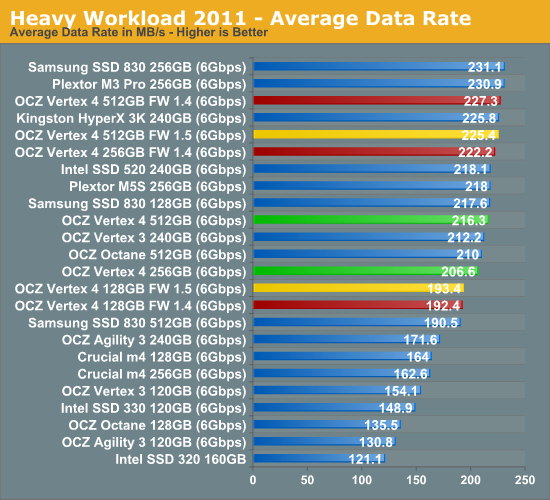
The 1.4 update brought a small boost in our Heavy suite. As you can see in the table above, most IOs are small and the 1.4 and 1.5 firmwares brought marginal improvements to small transfer size performance.
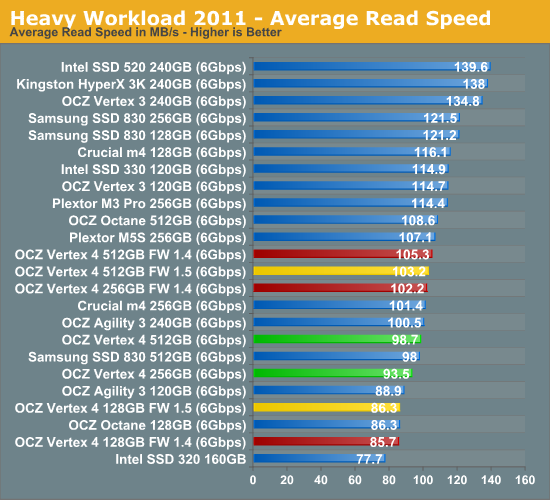
As I mentioned in the previous page, Vertex 4 still lacks read performance at small transfer sizes and the above graphs supports this. The average write performance is very good however and definitely makes up for the middle of the road read performance.
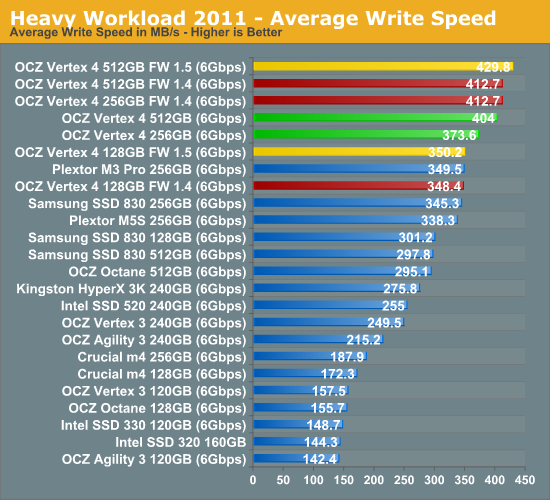
The next three charts just represent the same data, but in a different manner. Instead of looking at average data rate, we're looking at how long the disk was busy for during this entire test. Note that disk busy time excludes any and all idles; this is just how long the SSD was busy doing something:
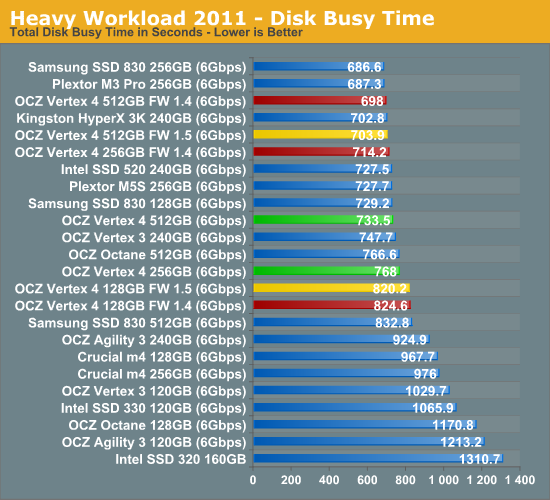
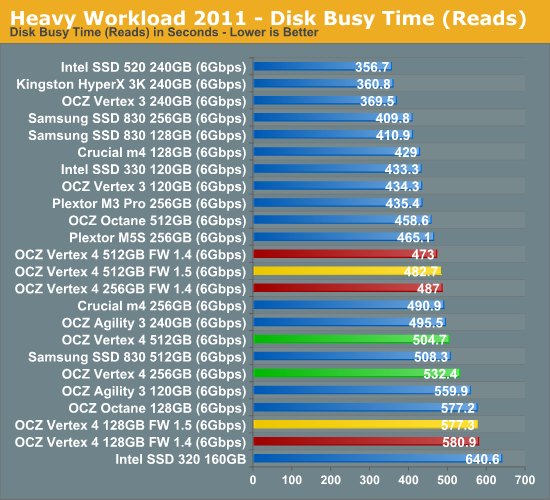
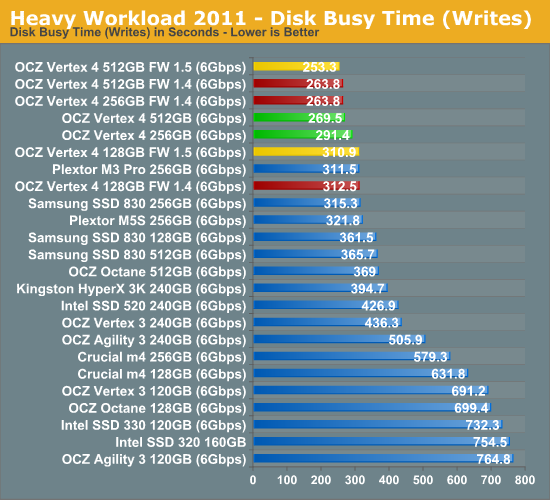










60 Comments
View All Comments
hybrid2d4x4 - Tuesday, August 7, 2012 - link
I agree with this. I care more about power consumption than incremental performance since I only have an SSD in my laptop for now, and the next one I buy will replace that 128GB F120 and my HTPC and eventually desktop will get them as hand-me-downssswing - Saturday, August 4, 2012 - link
Now it looks like we need a review comparing VTX4-25SAT3-512G & VTX4-25SAT3-512G.M since I haven't been able to find updated specs from OCZ. There's a big price difference but is the performance difference relatively equivalent?Movieman420 - Saturday, August 4, 2012 - link
Actually Ocz has been fore-warned not to repeat the same stunt they pulled when they switched from 34nm 32Gb dies to 25nm 64Gb dies without making it clear that there was a significant performance difference...esp with the 50 & 60gb drives that went from using 8 nand chips (1 per SF channel) to using only 4 chips and 4 channels. Anand took Ryan Peterson to task over the stunt and Ryan promised to differentiate models who's speed change by 5% or more I think.The '.M' drives with Micron nand are slower than the regular V4 with IMFT nand
Here's the thread at Ocz.
http://www.ocztechnologyforum.com/forum/showthread...
menting - Sunday, August 5, 2012 - link
huh? Micron NAND IS IMFT NAND.what was that support guy smoking?
semo - Monday, August 6, 2012 - link
Just to add that not only did the performance suffer but the capacity did as well. They also used Spectek NAND which wasn't what the reviews reported originally.In the end, OCZ managed to bury the issue without even issuing a mass recall of the affected drives. OCZ is a dodgy company and I'm glad that there is enough competition out there for me to avoid buying any of their products.
primeval - Saturday, August 4, 2012 - link
The performance is great and all, but without reliability I just don't see that many people jumping on board. No one wants to replace their SSD frequently.chaudx - Saturday, August 4, 2012 - link
How much of a drop in performance do other drives take when over 50% full?Benchmarking empty drives seems like a waste of time, as most people are going to fill them at least 50%, if not more.
Linuxhippy - Saturday, August 4, 2012 - link
What I really miss is an analysis, how much used capacity affects real-world performance.This way, it looks just a lot like an advertising campaing bought by OCZ ...
The review reminds me a lot about the SandForce benchmarks, where you had to subtract -25% once the drive had been written its capacity for the first time.
AFUMCBill - Saturday, August 4, 2012 - link
Anyone needing an SSD in a video recorder such as the Black Magic Design Shuttle 2 now knows to stay away from this drive. A real time application like that is going to be utterly intolerant of the drive deciding it needs to take a large timeout half way through. I am sure there are other applications in a similar situation to that.Beenthere - Saturday, August 4, 2012 - link
The way these companies rush out half-baked software, firmware and hardware is a crime. They should all be severely punished financially for using consumers as unpaid beta testers.If they continue to do this the executives of these companies should do prison time. This would reduce the exploitation of consumers and bring some sanity and integrity to business. Tolerating the illegally gotten industry monopolies and product price fixing sent a clear message to these criminals that anything goes and as such they are cashing in and using the media to further their unscrupulous behavior.